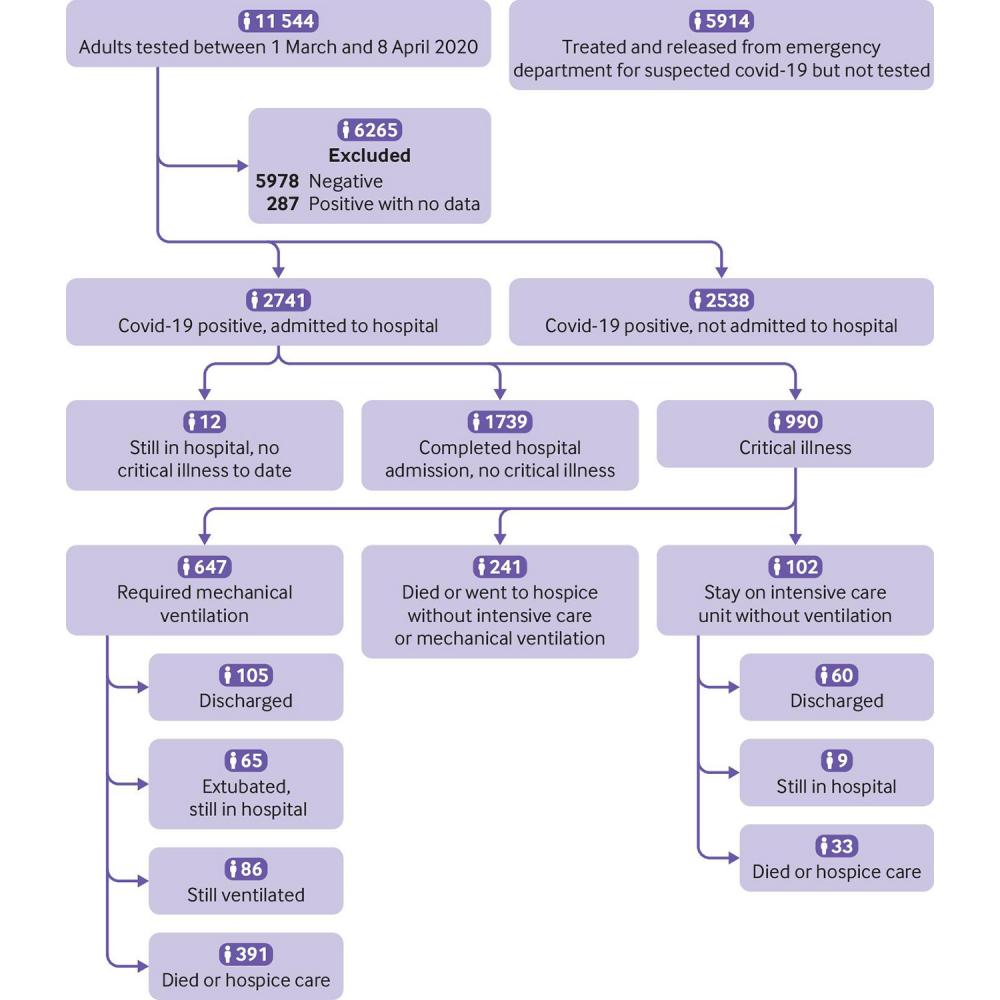A team of investigators at NYU Langone Health determined that a little more than half of 5,279 patients who received positive test results for 2019 coronavirus disease (COVID-19) were hospitalized—and nearly a quarter of those hospitalized died or were discharged to hospice, including 60 percent who required ventilators.
The study—recently published online in The BMJ—is the most complete report of outcomes for patients hospitalized with COVID-19 in the United States to date, according to the authors. The investigators found that while age and comorbidities were strong predictors of hospitalization, critical illness, and death, patients with low levels of blood oxygen (88 percent or lower) upon admission and those with markers of inflammation such as elevations in c-reactive protein, which is a substance produced by the liver in response to inflammation, were most likely to have the worst outcomes during hospitalization.
“Our findings provide a rich understanding of the characteristics of people most at risk for poor outcomes once they are hospitalized with COVID-19,” says Leora Horwitz, MD, associate professor in the Departments of Population Health and Medicine, director of the Center for Healthcare Innovation and Delivery Science at NYU Langone, and the study’s senior author. “We demonstrated that age, being male, being severely obese, and having certain chronic diseases like heart failure and kidney disease put patients at high risk for hospitalization for COVID-19. We also showed that the degree of oxygen impairment and markers of inflammation in patients were most strongly associated with poor outcomes during hospitalization.”
As a result, Dr. Horwitz says clinicians should routinely test patients with COVID-19 for inflammatory markers throughout their hospitalization. Another challenge, according to Dr. Horwitz, is that many study patients did not notice their oxygen levels were low. “If more people could monitor oxygen levels at home and come to the hospital earlier, perhaps that could improve their outcomes,” says Dr. Horwitz.
Responding to a Pandemic: How the Study Was Conducted
Investigators obtained all data from NYU Langone’s electronic health record (EHR) of inpatient and outpatient visits at the system’s 260 outpatient office sites and 4 acute care hospitals in Manhattan and Brooklyn and on Long Island. For data on tobacco use, body mass index (BMI), and comorbidities, the researchers included data in the EHR entered during prior inpatient or outpatient visits.
The research team assessed three primary outcomes: inpatient hospitalization; critical illness, defined as care in the intensive care unit, the use of mechanical ventilation, discharge to hospice, or death; and discharge to hospice or death among hospitalized patients. The study was conducted between March 1, 2020, and April 8, 2020. The final date of follow-up was May 5, 2020.
Study Findings
The following are key findings from the study:
- Of 5,279 patients who received positive test results for COVID-19, 2,741 (51.9 percent) were hospitalized, 1,904 (69.5 percent) were discharged, and 665 (24.3 percent) died or were discharged to hospice.
- Of 647 (23.6 percent) hospitalized patients who required ventilators, 391 (60.4 percent) died and 170 (26.2 percent) were discharged.
- The strongest risk for hospitalization was age: 40 percentage point increased risk for patients ages 65 to 74, and 58 percentage point increased risk for patients age 75 years or older.
- The strongest risk factors for developing critical illness—besides age—were heart failure, chronic kidney disease, BMI greater than 40, and sex (male over female). However, blood oxygen levels below 88 percent upon admission and markers of inflammation were more strongly associated with critical illness than age and comorbidities.
- 53 percent of hospitalized adult patients were younger than 65 years of age.
- Risk of critical illness and death among hospitalized patients decreased significantly during the study period, suggesting that the ability to care for these patients improved, even without definitive “game-changing” drugs.
Certain findings, according to lead author Christopher M. Petrilli, MD, assistant professor in NYU Langone’s Department of Medicine, and colleagues, were more difficult to explain.
“We were expecting that asthma or chronic obstructive pulmonary disease would increase risk of both hospitalization and critical illness, but the risk was much smaller than what we were expecting,” says Dr. Petrilli. “Meanwhile, patients with heart failure and chronic kidney disease were at much higher risk. We still don’t really understand why certain diseases seem to put people at more risk than others.”
“While we continue to study outcomes in patients who tested positive for COVID-19 to create reliable real-time tools, the next phase of investigation will be development of predictive risk models to build into provider workflows, analyzing differences in outcomes across different hospitals to identify best clinical practices, and, finally, looking at non-COVID patients who may have delayed medical care from being fearful to come to the hospital,” Dr. Petrilli says.
Despite age being the greatest risk for hospitalization, critical illness, and death, Dr. Horwitz cautions everyone to take COVID-19 seriously. “It’s important to distinguish population risk from individual risk,” she says. “If you are young, that doesn’t mean that you can’t get the virus. Almost a third of our hospitalized patients are younger than 55. Similarly, having chronic diseases increases risk, but one in five of our hospitalized patients had no chronic conditions.”
In addition to Dr. Horwitz and Dr. Petrilli, co-authors from NYU Langone are Simon A. Jones, PhD; Jie Yang, MS, MPH; Harish Rajagopalan; Luke F. O’Donnell, MD; Yelena Chernyak; Katie Tobin, MPH; Robert J. Cerfolio, MD, MBA; and Fritz François, MD. Funding for the study was provided in part by the Kenneth C. Griffin Charitable Fund.
Media Inquiries
Sasha Walek
Phone: 646-501-3873
sasha.walek@nyulangone.org


